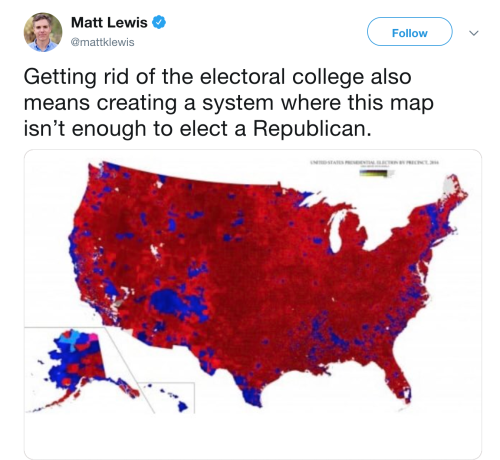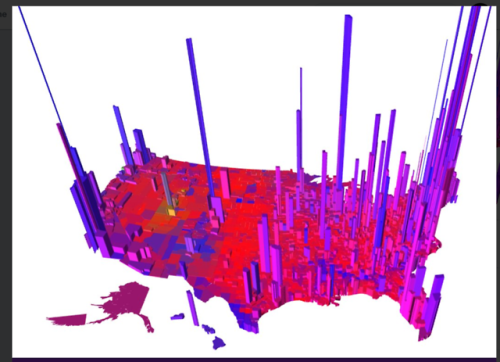fandomsandfeminism: cheesey-toast:cecaeliawitch:randomheresy:politicalprof: Maps matter. Map 1
fandomsandfeminism: cheesey-toast: cecaeliawitch: randomheresy: politicalprof: Maps matter. Map 1 over-represents territory. Map 2 is weighted by where people live … Right. Plus, a lot of blue people live in those red areas. Rural districts tend to be dominated politically by those who control the land and resources. The owners are overwhelmingly conservative, and they are able to control the politics of the lands and people they own, but a lot of people suffer for it. boy, he’s super close to admitting that a straight-up vote can’t win the republicans anything so they feel entitled to cheat. The whole reason the electoral college was created in the first place was so that denser cities wouldn’t have the upper hand in elections. Because, I realize this may be shocking to some of you, but people who live in the same area tend to have similar views. So It’s not fair for the people who live in less densely populated areas– that account for wider swathes of land than the more densely populated areas– that they don’t get the “benefit” of living in an area where exponentially more people hold the same views as them. The electoral college accounts for this disparity where the public vote does not. I’m sure you’re all perfectly happy to let NYC and LA decide every national vote– until it’s something you disagree with. I mean, it was ACTUALLY put in place as part of a compromise with Slave States, but sure. Let’s PRETEND that the INTENT of the Electoral College is to ensure that the presidential candidates have to pay attention to ALL citizens. If that is its purpose, it is SPECTACULARLY bad at it. Two-thirds (273 of 399) of the general-election campaign events in the 2016 presidential race were in just 6 states (Florida, North Carolina, Pennsylvania, Ohio, Virginia, and Michigan). 94% of the 2016 events (375 of the 399) were in 12 states. The reason for this is simple: States that have a strong majority towards one party already are considered “safe” and not worth campaigning in. It doesn’t matter that almost 4 MILLION Texans voted for Hillary. It doesn’t matter that 4 and a half MILLION Californians voted for Trump. Those states, and any state that isn’t considered a battle ground state doesn’t get heard during campaigns because the chance of flipping the ENTIRE state is very low. That means that if you don’t live in a battle ground state, then you really don’t get a say. On the other hand, if we went to a POPULAR VOTE (ya know, like every other election we have in this country, including your Governor) then all those votes WOULD matter. All the Republicans in “blue” states and all the Democrats in “red” states would need to be targeted; they could swing an election. Instead of being beholden to what Ohio thinks is important and building campaign promises around that, candidates would have an incentive to visit mid-sized cities all over the country to reach undecided voters regardless of where they live. Right now we have a system where “states” vote as solid blocks, which intentionally and completely erases political minorities within those states. This reduces voter turn out because of a feeling that your vote doesn’t matter (and like…it really kinda doesn’t) and creates this disproportional power in a very very small number of citizens (those who happen to live in battleground states.) Under the EC, Candidates are rewarded for focusing all of their attention, energy, and campaign promises on the small number of states where undecided voters can swing the majority their way, leaving the vast majority of the country ignored. What about the BIG CITIES you say? #1 New York City. 8,601,186 #2LosAngelesCalifornia 4,057,841 #3Chicago,Illinois 2,679,044 #4Houston,Texas 2,359,480 #5Phoenix,Arizona 1,711,356 #6 Philadelphia,Pennsylvania 1,576,596 Those 6 cities, combined, have less than 22 million people. The US has 327 million. And this is my point- the US is not made of a small handful of huge cities. The vast majority of the country lives in SMALL cities and towns, under a million people each, and their suburbs. So, no, with the Popular Vote, you could not pander just to the biggest cities and be done with it. If you add up EVERY SINGLE CITY with more than 100,000 people in it (Which is 311 cities), that’s still only 94 million. 28% of the US population. The EC doesn’t actually help rural populations. In fact, it makes things worse for them. 46 states have an urban majority, and “winner-take-all” laws that have been enacted by state legislatures in 48 states. So if there is a stark divide between rural and urban populations, in 46 states, the urban votes will win and 100% of the electoral points will go to the urban side. However, in a popular vote system, no one’s vote would get thrown away like that, and everyone’s vote would be counted equally in the final tally.The popular vote would actually give MORE voice to rural populations that are all but completely erased in our current system. And it is important to remember that in reality cities do not vote in perfect blocks. Neither do states. Even the most liberal city has conservative voters and even the deepest rural hellholes in Texas has progressives (I was one of them until I moved for college!) Those people matter. Those people should count. Why not have a system where CITIZENS elect the president? Why does it matter which state someone lives in, if all votes should count equally? This is a REALLY good website about the popular vote and it debunks a lot of common myths about the Electoral college. -- source link
Tumblr Blog : politicalprof.tumblr.com

